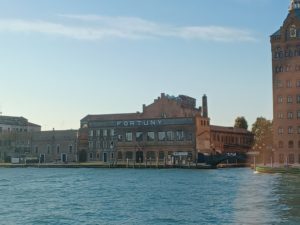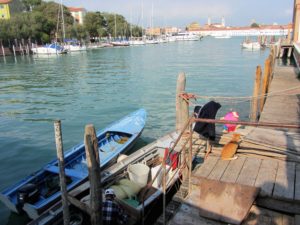“For details of opening times of the Fortuny showroom”:https://fortuny.com>venice
n 2017 my sister and her husband came with us to Venice and we took them over to the neighbouring island of Giudecca, mainly so they could enjoy the views from the island but also because my sister and I are extremely interested in textiles, interior design and also vintage fashion. We were looking for the Fortuny textile factory but were not really sure it was still in operation. On this occasion we got the vaporetto at the San Basilio stop in Dorsoduro for the short crossing to Sacca Fisola which is a small island at the western end of Giudecca. Sacca Fisola is mainly residential with large areas of what looks like social housing, blocks of flats that were probably built in the 1980’s/90’s, but there are also playing fields and sports facilities including a public swimming pool. We found the path that led to the bridge that links it to Giudecca and as we walked across could see the huge Hilton Molina Stucky hotel to our left. At the other end of the bridge we stopped to watch a fisherman sorting out his catch of crabs with an egret eagerly waiting for some scraps, then a bit further on we turned a corner and saw the back of a factory that we thought must be Fortuny, then round another corner where we walked alongside the Rio di San Biagio to the waterfront of the Giudecca Canal facing the main island and across another bridge to the front of the building that still had `FORTUNY` in large letters on the brickwork. However, the only door was behind a gate into a courtyard. As we couldn’t see a bell to ring we peered through the windows and saw some beautiful furniture and table lamps inside that almost looked like someone’s home. We had just given up and started to walk away when my husband called us back as a lady had seen us looking in and had come out to invite us in to what turned out to be the Fortuny showroom. Inside there were easy chairs, a selection of lampshades, cushions and other interior design items all covered with exquisite Fortuny fabrics. Another room was piled high with bolts of fabric and lengths were displayed on the walls. The lady was a guide/saleswoman who had just started giving a talk about Mariano Fortuny to an American couple who were obviously there to make some serious purchases and so were none too pleased when the guide started her talk again from the beginning for our benefit.
She told us how Mariano Fortuny y Madrazo, who was born into a family of artists in Spain, moved with the family in 1889 from Paris to Venice and became a prolific painter, etcher, sculptor, photographer, architect and inventor; one of his many projects was to modernize stage lighting and set design using his theories of indirect and diffused light. In 1897 he met Henriette Negrin in Paris and she moved to his home in Venice, the Palazzo Orfei, in 1902. Henriette was an experienced dressmaker and she helped Mariano construct many of his fashion designs, most notably the Delphos gown, which was a shift dress made of finely pleated silk weighted with glass beads. He began working on textiles that are still manufactured today, using his own formulas to make dyes and pigments that were based on ancient techniques. He printed on velvets and silks but also used cotton, which was much cheaper, but by using a clever printing technique it looked like silk. In 1921 he wanted to expand his textile manufacturing and bought some land on Giudecca from Giancarlo Stucky, next to the Stucky flour mill. The site had originally housed a convent that had been closed by Napoleon and then used industrially and here Fortuny had the factory built to his precise specifications to house the machines he invented for the production of his textiles. In 1927 an American designer, Elsie McNeill Lee, saw and liked his work and thought the fabric could be sold to decorators and designers in the United States. She was to become the sole distributor of his fabrics and dresses in the US from her shop in New York. Mariano Fortuny died in 1949 and his widow asked Elsie to take over running the company, which she did until 1988, when she passed it to her closest confidante, Maged F. Riad, who died in 1994. The Riad family continues to run the factory, using the same machines and methods used by Fortuny a century ago, although dress fabric is no longer made. There is still a showroom in New York.
Unfortunately the factory itself is not open to the public as the manufacturing processes are top secret; we weren’t even allowed to take photos of the showroom. After the talk we wanted to buy some souvenirs but everything was very expensive. The aforementioned American lady ran an interior design business in New York and was choosing roll ends to be made into cushions – even a piece of fabric, enough for one cushion, was 200 euros! Eventually my sister and I decided to buy fabric covered journals/notebooks and another assistant searched the storeroom for colours and designs that we liked, even though we were clearly `poor relations`. My small journal covered with a typical Venetian print on a metallic background was popped in a printed paper carrier along with a brief history of the Fortuny factory. The showroom opening times can be found online and the adjacent garden is open by appointment in summer months. At least I hope it is still open as I haven’t yet had a chance to see the garden. .














